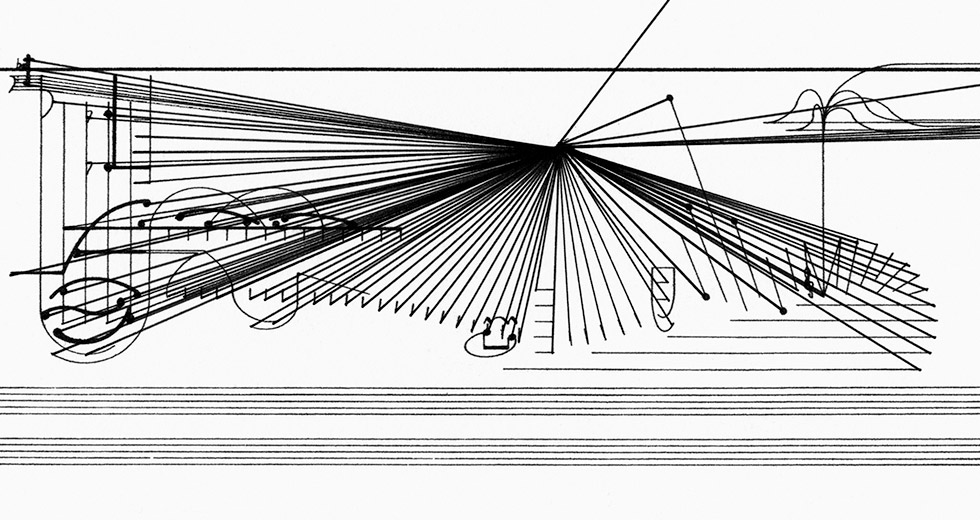Wandelweiser: The Sound of Silence
Jeremy D. Larson on the unique collective of composers
Listen to Undertones, Jeremy D. Larson's RBMA Radio show, and its episode devoted to Wandelweiser here
Formed in 1992 by the Dutch composer and flutist Antoine Beuger and the German composer and violinist Burkhard Schlothauer, Wandelweiser was at first a boutique label comprised of a few musicians who had a desire to make music outside of the monied classical institutions of Europe. Today, it has ballooned into a movement, a loose group of 20 or so international artists who perform their minimal and austere compositions around the world.
Some compositions are brief, like Jürg Frey’s sparse, three-minute “Wer macht das Stück.” Others stretch on for hours, or even days. Manfred Werder’s “stück 1998” exists across four thousand pages and consists of 160,000 “time units,” each lasting 12 seconds, each equally divided between pitch and silence. If performed beginning to end, the full running time of “stück 1998” would be over 22 days. An excerpt from pages 676 to 683 lasts just over an hour and there is hardly a note to be heard.
While each member of Wandelweiser composes using their own style and personality, there is one fundamental sound and lifestyle that unites them all: silence. Spend just thirty seconds with a Wandelweiser composition and it becomes obvious its provenance is tied to John Cage, the high priest of quiet.
There is no prerequisite to enjoying the serenity of Wandelweiser, but it helps to put into context Cage’s groundbreaking thoughts on silence as sound, as it plays a crucial part in these ambient and beautiful compositions. To hitch a piece of music to silence requires a reorientation towards a new, indeterminate kind of math. Cage writes: “The common denominator is zero, where the heart beats (no one means to circulate his blood). A sound has four characteristics: frequency, amplitude, timbre and duration. Silence (ambient noise) has only duration. A zero musical structure must be just an empty time.”
Silence (or zero, or “where the heart beats”) is a large and uncertain space that dares to be impregnated with what is around you and what is inside you. Silence in music can bend time to show that our feelings and experiences in this world are not determined by time itself. In spending real time with Wandelweiser and its composers recently, this new orientation to quiet reopened a passionate response to music. It is not because it creates an escape like so much great pop, rock and dance music, but precisely because Wandelweiser offers no retreat.
There is a sandpiper perched on top of a power line, a vista copied from a Corona billboard and these Wandelweiser pieces for solo piano.
It’s actually funny, I think, because I’m listening to the taciturn music of Wandelweiser under swaying palm trees while a few miles down Highway 1 the music of James William Buffett pipes into the never-ending happy hours of Key West. There is a sandpiper perched on top of a power line, a vista copied from a Corona billboard and these Wandelweiser pieces for solo piano – semitones stretched across the piano, suspended triads clustered around middle C, small Dorian motifs slouching leftward – mark this island time in the common denominator of zero, aligned with some fundamentally broken clock. A passing fishing boat finds the tonic of Jürg Frey’s “pianist, alone” until the doppler effect bends the sound of the motor a few steps lower. A rain shower rolls in to the jazzy clusters of Eva-Maria Houben’s “abgemalt” like natural tape hiss. These Cagean moments are so ardent and affirming that I’d like to think they have permanently altered the spirit of Margaritaville.
I’m here in the Florida Keys to, among other things, help my mother write a eulogy for her sister. At the risk of lapsing into the maudlin, it has simply been a hard week and year. But the truth is there is no escape from that which is present when listening to Wandelweiser. It doesn’t suggest a mood, it collects life in its vaulted silences. If this music can transform this tropical and drunken stretch of islands into a timeless and introspective booth of emotion, surely its power can be accessed at any place and time in the world.
I would wade into Wandelweiser first with “go and stop,” a 2002 piece for solo piano by the German composer Eva-Maria Houben. The score indicates that the performer should “zeit lassen…” or “leave time…” as desired. The scenes of its dense minor chords come through the speakers, anchored always by the periodic striking of a low F and its trail of overtones.
As advertised, the piece is indeed halting, but it is as if the motion is the silence and the inertia is the music. This inversion happens often with the solo and ensemble works of Wandelweiser: Sometimes you’re not even listening to the music, but listening to yourself listening to the music.
Take also the solo piano works of Swiss composer Jürg Frey. In their Zen-like length and plodding journey, there are long patterns of open fourths and fifths attached to the time of a comatose heartbeat, with only faint up- and downticks in tempo. In his 90-minute piece “pianist alone,” Frey moves through many sections that begin to bleed in and out of memory. You recall the sound of these open chords in the beginning, but the time of the piece seems to alter how they are perceived, or if they even existed at all. Your focus dims, and you become a part of the liminal space between the music and the silence, where each strike of the piano becomes a hurdle. Some feel like anthills and some feel like mountains.
Much like the glass houses of Mies van der Rohe, or the unassuming paintings of Ad Reinhardt, the form of Wandelweiser relies heavily on the imprint of its surroundings. The performer, the listener, and the venue become part of the piece. We like to think of noise music and extreme metal as confrontational, as the theatrical metal group Sunn O))) put it: “Maximum volume yields maximum results.” But the music associated with Wandelweiser does not force a confrontation with the performer of the composer. Wandelweiser forces a confrontation with both the world around you and the world inside of you.
Michael Pisaro, the foremost American member of Wandelweiser, further describes this feeling:
In our music, the listener’s time and musical time meet halfway. The music, by taking its course, by being always on its way but never in a hurry, redirects the feeling of time. We may follow its progress easily, and therefore need not devote much effort to staying on the path. In this situation, our eyes stray to the path running alongside us, on which someone just like us is walking. In this way the music is a mirror in which we see ourself, reflected through a gauze made of time that is stretched across a mirror. The gauze is held in place by sound.
Of course, delving into the ontological infinity of silence feels a little navel-gazing, or maybe a gobbledygook excuse to involve yourself in the art.11Though, if you want a much deeper take on silence in music, I recommend composer Taku Sugimoto’s brief essay A Philosophical Approach to Silence
But this ego-free dismantling of power is in part what Wandelweiser, and many of the post-Cagean composers, seek to achieve. It is egalitarian music in service of realization, which, as Jennie Gottschalk writes in her book Experimental Music Since 1970, is a key component of experimentalism. “The experimentalist is not trying to change the musical world, but to change the thinking of one or more listeners during – and possibly after – the performance.”
There is nothing revolutionary about the aleatory plucking of piano notes in free time, and the pieces of Wandelweiser are composed with such skill that to describe it foremost as therapeutic would be a huge disservice to the detail put into the scores. Yet the silence of Wandelweiser has created such a deep connection with the world around me, the sorrow of losing my aunt, the dread, and pessimism of American politics, these biblical and grandiose feelings of death and celebration. Life swirled within the silence, the heartbeat, the zero musical structure of the songs.
I don’t feel great, but I feel present. I feel there is nowhere to hide, but feel spurred to action. What I now believe to be true: A change in attitude requires more than a change in latitude.

